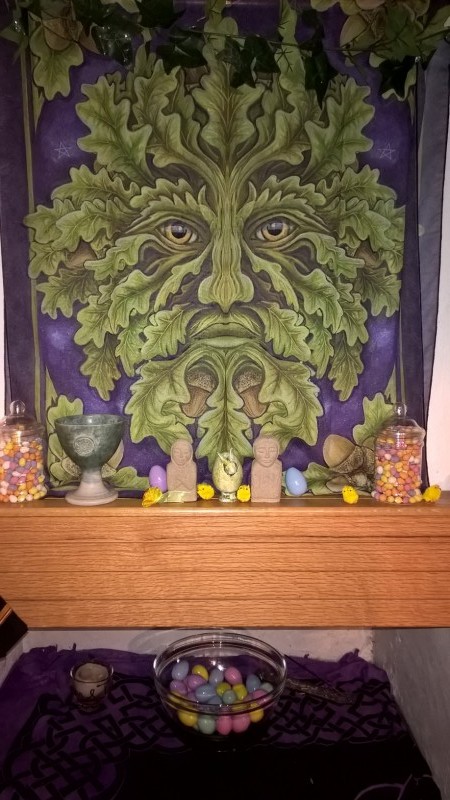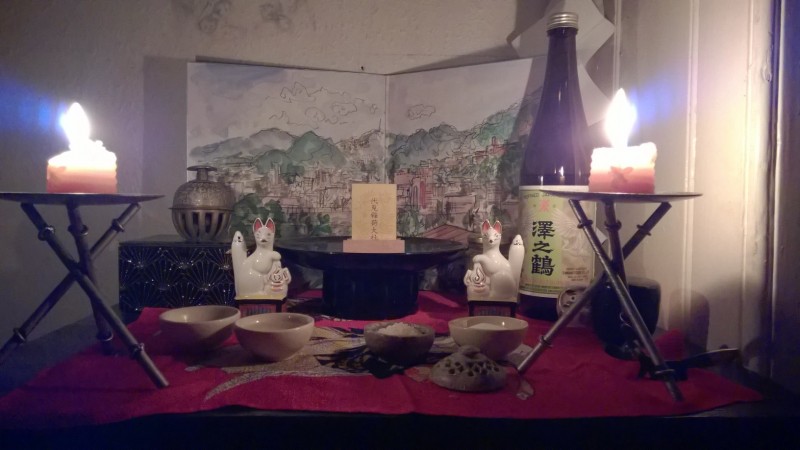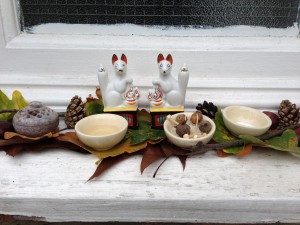
A Pagan Shrine for Ostara with easter eggs and stone figures of Mary & Joseph from a Saxon-inspired nativity set – a syncretic touch in a postmodern age
With the spread of Shinto overseas, there are some exciting transformations taking place as innovators adapt Japanese practice to their needs. This is particularly evident in the marriage of Shinto to contemporary paganism, with pioneers creating something that might be called Neo-Shintoism. (See an earlier piece on Minzoku NEO-shinto.)
One of the most articulate advocates of the neo-Shinto movement is Megan Manson, an eclectic pagan practising in the UK and piecing together a remarkably coherent set of practices. She runs her own blog, has lived in Japan and is involved with Japan-UK relations. In a recent article for the interfaith Patheos site, she wrote of “How I found the Shinto-Pagan Path“, and in the extract below she describes what initially drew her to Shinto.
**************
There are many possible reasons for the harmonious relationship between the scientific rationality and spiritual outlook held by a large proportion of the Japanese population, but I think one of the most important is that in Shinto, actions take precedence over belief. In my experience, many Japanese aren’t too sure what they believe at all – additionally, they do not consider having well-defined spiritual beliefs as particularly important. They’ll carry on making pilgrimages to shrines, going to festivals and taking part in seasonal Shinto rituals without worrying too much about whether or not the kami really exist. They do it partly because they enjoy doing it; it feels “right” to them.
When I realised this, I understood that this was the missing piece of the puzzle for me. I had approached Paganism from a Western, Christian perspective, probably due to my Catholic background. I thought that faith was a fundamental starting point for spirituality, and that one had to essentially choose between whether to trust in science or believe in religion. Shinto taught me that this was not the case at all. It taught me that it was OK to be a Pagan for no other reason than it feeling “right,” and that one could still follow a religion and hold scientific fact to be just as valid. As I grew to learn more about Neopaganism and the Pagan community, I realised that many other Pagans in fact feel exactly the same way.
I continued to use Shinto as a framework for my Pagan beliefs, and as I did so, I realised that I was becoming increasingly drawn to venerating the Shinto kami themselves along with Western Pagan deities, and one kami in particular: Inari Okami. Carrying across the Neopagan concept of a “patron” deity, I set up an altar to Inari in the courtyard outside our house, where we would often be visited by foxes. Inari has been my patron ever since.
Seeing the fox cross my path [one] summer afternoon gave me a moment of intense clarity. I understood that my interests in Paganism, science, and Japan were all connected. Whether or not this was truly a message from Inari, I suppose I’ll never know, but it was enough to confirm that I’d found the spiritual path for me – one that blended all of these ideas together.
So now I consider myself a Shinto-Pagan, practising both religions side by side. I celebrate the eight festivals of the Neopagan Wheel of the Year in addition to Japanese festivals. I participate in a local moot where our rituals are very much Wicca-influenced, invoking the Great God and Goddess and involving circle casting and calling the four elements; I also make regular offerings and Shinto norito prayers at my Inari altar.
To me, it seems natural to combine western Paganism with Shinto. Not only do the two religions have much in common in terms of their focus on ritual, nature worship and sense of duty to the ancestors, but as mentioned previously, Shinto is rarely practised in isolation from other religions in Japan. For me, Shinto is like a reactive chemical element – it likes to “bond” to other religious paths to create a new path that is best-suited to the practitioner. I find that my Shinto and Neopagan paths really complement and enhance one another. Even my blog’s title (Pagan Tama) reflects the Shinto-Pagan blend; the word “tama” is of special significance in Shinto and can be translated as “soul.”
Where my path will lead from now, I’m not sure. I feel that there is so much out there to learn and that I’ve only just begun. But as the Japanese say, senri no michi mo ippo yori hajimaru – “Even a journey of a thousand miles begins with a single step.”
********************
For a podcast with Megan, click here. Megan talks about her path to Shinto, some of the history of Shinto and how it relates to the other religions practiced in Japan. What is the difference between Japan and the West in regards to religious identity? What does it mean to be multi-faith, and how do we explain it to others?

Megan’s Shinto shrine is dedicated to Inari Okami. The picture behind is a painting done by an art teacher at the school in Nagasaki where she used to work – a view from the school window that now acts as a “window to Japan”.


Thank you so much John for this fascinating essay. I am neopagan and had started to incorporate Shinto into spiritual practice last year. I set up my kamidana and ofuda, and was learning the norita. I got a real sense of presence from the ofuda. Eventually, I’m sorry to say, I let this practice lapse. At the end of the year I sent my ofuda back to their shrine for the burning ceremony. I had a strong sense not to replace them, perhaps out of respect for the practices they require.
I have subscribed to Megan’s blog now, too, thanks to you!
Thank you for writing in, Jude, and I’m glad you found it of interest. I think there’s a very real trend of neo-pagans familiar with Japan adopting Shinto practices, because they make so much sense, are beautiful in form, and are the product of a long tradition. Personally I hope to hear more about individuals like yourself who are pioneering new forms of spirituality, because I think there’s a need to support those whose practice would be considered ‘unorthodox’ by the mainstream. People like Megan are creating a new type of flexible spirituality that meets the demands of our time.
Thanks to Megan for a fascinating post. It rang true to me. I have a Buddhist friend who I asked what had attracted her to that faith. She said to me ‘it just made sense’. It felt right to her. Reading how Megan calls on the four elements of Wicca I would be interested to hear if she had discovered a complementary set of elements in Shinto?
Hi Jann! Thank you so much for your lovely comment :) Well, there’s lots of things you can do with the elements if you wanted to incorporate a bit of Shinto. You could call them in Japanese (sometimes I trace the kanji for each of the four elements in the air when I call them), or call upon kami specific for those elements (so Sujin for water, Sarutahiko for earth etc. etc.). You could also add “void” to the standard elements, as this is included with the other four in Japan (more information here https://en.wikipedia.org/wiki/Classical_element#Japan). Finally, you could substitute the four classical elements with the five Chinese elements associated with Feng Shui, as this wouldn’t be completely out of place in a Shinto context; these are water (north), wood (east), fire (south) metal (west) and earth (centre). Each have their own colour and other associations much like the classical four elements. You may also come up with your own other ideas for working with the elements in a Shinto-Pagan blend. Enjoy!
Thanks for your detailed response Megan. It was very helpful and thought-provoking. The steps you are taking are sure to take you on an amazing journey.
Hello. I am a young, newly practicing pagan Wiccan trying to find my patron or patrons. I have a very strong draw to Japanese culture and would like to worship Shinto gods and goddesses as well, but I don’t know either a, if it’s respectful to do so while not explicitly practicing Shinto, and b, how to do so in the first place. Do you have any advice?
There are those who say it’s not respectful to mix religions or worship native deities with an imported ritual system, such as Shinto. On the other hand there are those who are mixing Shinto with native practices such as Wicca to good effect. For an example, please take a look at the website of Megan Manson (search on the net or on this blog). In the end though, it’s up to you and whatever spirits call to you. Follow your heart…
Thank you Megan for your wisdom. I’m not a “devote” Shintoist but I do follow certain beliefs. At the same time I recently started practicing Tarot. Unfortunately, there are no connections to Tarot in Shintoism as far as I am unaware. And after a particular social media post I came across had me questioning my beliefs, your blog helped me realize there was more to explore in my faith. I feel like Neo-Shintoism is where my religious destiny lies and hope to earn my right to call myself a Shinto-Pagan.